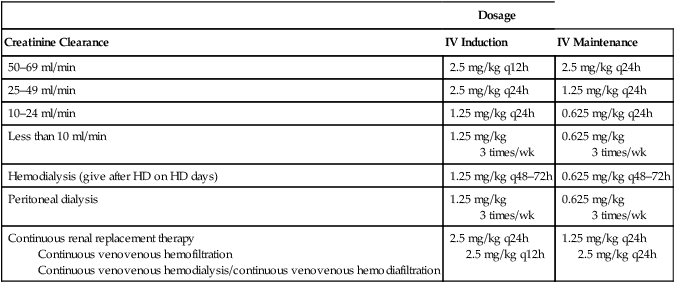(Apo-Gabapentin Do not confuse Neurontin with Motrin, Neoral, nitrofurantoin, Noroxin, or Zarontin. Note: When given 3 times/day, maximum time between doses should not exceed 12 hrs. Dosage and frequency are modified based on creatinine clearance: Do not confuse Cytovene with Cytosar, or ganciclovir with acyclovir. Dosage and frequency are modified based on creatinine clearance (see table). Do not confuse gemcitabine with gemtuzumab, Gemzar with Zinecard. Dosage adjustments should be based on granulocyte count and platelet count, as follows: (Apo-Gemfibrozil Do not confuse Lopid with Levbid, Lipitor, Lodine, or Slo-Bid.
G
gabapentin
![]()
![]() , Gralise, Horizant, Neurontin)
, Gralise, Horizant, Neurontin)
Indications/routes/dosage
Dosage in renal impairment
Creatinine Clearance
Dosage (Immediate-release)
(Extended-release)
60 ml/min or higher
300–1,200 mg tid
1,800 mg once/day
30–59 ml/min
200–700 mg q12h
600–1,800 mg once/day
16–29 ml/min
200–700 mg once daily
Not recommended
Less than 16 ml/min
100–300 mg once daily
Not recommended
Hemodialysis
125–350 mg after each 4-hr hemodialysis session
ganciclovir
Indications/routes/dosage
Cytomegalovirus (CMV) retinitis
Dosage in renal impairment
Dosage
Creatinine Clearance
IV Induction
IV Maintenance
50–69 ml/min
2.5 mg/kg q12h
2.5 mg/kg q24h
25–49 ml/min
2.5 mg/kg q24h
1.25 mg/kg q24h
10–24 ml/min
1.25 mg/kg q24h
0.625 mg/kg q24h
Less than 10 ml/min
1.25 mg/kg
3 times/wk
0.625 mg/kg
3 times/wk
Hemodialysis (give after HD on HD days)
1.25 mg/kg q48–72h
0.625 mg/kg q48–72h
Peritoneal dialysis
1.25 mg/kg
3 times/wk
0.625 mg/kg
3 times/wk
Continuous renal replacement therapy
Continuous venovenous hemofiltration
Continuous venovenous hemodialysis/continuous venovenous hemodiafiltration
2.5 mg/kg q24h
2.5 mg/kg q12h
1.25 mg/kg q24h
2.5 mg/kg q24h

gemcitabine
![]()
Indications/routes/dosage
Pancreatic cancer, non–small-cell lung cancer (NSCLC)
Absolute Granulocyte Counts (cells/mm3)
Platelet Count (cells/mm3)
% of Full Dose
1,000 and
100,000
100
500–999 or
50,000–99,000
75
Less than 500 or
Less than 50,000
Hold
gemfibrozil
![]() , Lopid, Novo-Gemfibrozil
, Lopid, Novo-Gemfibrozil ![]() )
)
G
Get Clinical Tree app for offline access

 classification
classification classification
classification classification
classification classification
classification classification
classification classification
classification

